Please report any broken links or trouble you might come across to the Webmaster.
Please take a moment to let us know so that we can correct any problems and make your visit as enjoyable and as informative as possible.
| Click On Image For Full Size | Size | Image Description | Source | |
|---|---|---|---|---|
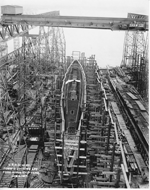 |
1.60k | Schley (SS-52) forward looking aft, 9 January 1917. Note the construction of two other submarines on the ways to the left. The only other submarines under construction at Fore River were O-3 (SS-64) thru O-6 (SS-67), which were all laid down between 2 thru 8 December 1916. |
Photo & text i.d. courtesy of David Johnston US National Archives photo # 19lc 11 from NARA, College Park, Maryland, courtesy of Sean Hert. | |
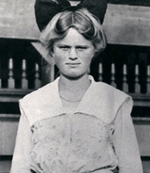 0806711 |
704k | O-6 (SS-67) Sponsor was Mrs. Carrol Q. Wright (Dessaline Shepard), wife of Lieutenant Carroll Quinn Wright Jr., U. S. Navy, prospective commanding officer of the vessel. | Text from Ships of the United States Navy and Their Sponsors, pg. 159 | |
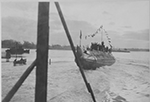 |
316k | Launching of the O-6 (SS-67), 25 November 1917. | National Archives Identifier: 45547172 Local Identifier: 165-WW-499A-20. Photo courtesy of catalog.archives.gov | |
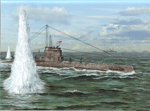 | 686k | An oil painting by Peter Bull of the moment the submarine O-6 (SS-67) was fired on by the last ship of a convoy she was deployed to protect while operating from Cold Spring Inlet, New Jersey, in January 1918. One of the escorting destroyers then gave chase. The subs crew attempted to signal the destroyer with all available flags. The destroyer then swung broadside to and fired several broadsides, all falling short. The crew of O-6 then began signalling with whistle. The destroyer finally came within hailing distance and turned out to be the Paul Jones (DD-10. | Image scanned from "U.S. Submarines 1900-35" by Jim Christley and illustrated by Peter Bull. Published by Osprey Publishing Ltd, ISBN978 1 84908 185 6, courtesy of Robert Hurst. | |
 |
265k | Photo showing shell hits on the submarine O-6 (SS-67) in one minute of firing by the American steamer Muskatine at a range of 4,000 yards, in August 1918. | Photo & text courtesy of A History Of The Transport Service: Adventures And Experiences Of United States Transports And Cruisers In The World War New York, via Robert Hurst. | |
 |
746 | O-boats of Submarine Division Eight at the Charleston Navy Yard, South Carolina, circa Christmas 1918. Note holiday greenery displayed on the submarines' superstructures. The three outboard submarines are (from left to right): O-6 (SS-67); O-3 (SS-64); and O-7 (SS-68). The two-stack ship in the left center distance is probably Dubuque (PG-17). Copied from the collection of David J. Lohr, by courtesy of Radioman 1st Class Pamela J. Boyer, USN, 1986. | US Naval Historical Center photo # NH 101013. | |
 |
56k | Savannah (ID-3015) with O-boats alongside, circa 1919. O-6 (SS-67), is outboard at Savannah's bow, and O-8 (SS-69) is outboard at her stern. | USN photo # 98630 courtesy of Jim Kazalis, 1981. From the collections of the US Naval Historical Center. | |
 |
85k | O-6 (SS-67) in drydock with other O-boats at the Charleston Navy Yard, South Carolina, circa 1919. | USNHC photograph # NH 103186. Collection of Christopher H.W. Lloyd. Donated by Virginia Agostini, 1990. | |
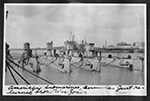 |
579k | U.S. submarines at Bermuda. Just returned from war zone. From left to right, 2 unidentified O-boats, O-3 (SS-64), O-5 (SS-66) & O-7 (SS-68). On 2 November 1918 O-boats 1 / 10 (SS-62 / 71) departed Newport with a 20-sub contingent bound for European waters, however, the Armistice was signed before the ships reached the Azores, and they returned to the United States. |
Text i.d. courtesy of DANFS. Photo by James W. Anderson, courtesy of Kristina Magill via Gary Priolo. |
|
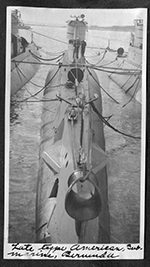 |
1.04k | Late type American submarine, Bermuda. One of the unknown 10 O-boats 1 / 10 (SS-62 / 71) . | Photo by James W. Anderson, courtesy of Kristina Magill via Gary Priolo. | |
 |
423k | One of the most interesting divisions of the battle fleet is that comprised of submarines. Here the O-6 (SS-67) and the O-1 (SS-62), two of the very latest types in our navy, are shown coming to anchor off Forty-seventh street. | Photo by Paul Thompson. Image and text provided by The New York Public Library, Astor, Lenox and Tilden Foundation. Photo from the The Sun. (New York, [N.Y.]) 1916-1920, 20 April 1919, Section 5 Pictorial Review, Image 55, via chroniclingamerica.loc.gov. |
|
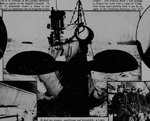 |
659k | A steel sea monster, amphibious and formidable, is Uncle Sam's newest submarine just home from war duty. The great fin rudders stabilize the boat under water and assist in speedy submerging. They fold up snugly against the sides when the "sub." is under way. Several of these new O-boats are making their initial New York appearance in the Naval Review. | Image provided by: Library of Congress, Washington, DC. Photo from the New-York Tribune. (New York [N.Y.]) 1866-1924, 27 April 1919, Image 47, via chroniclingamerica.loc.gov. |
|
 |
85k | Submarine Division 8, Commander Guy E. Davis commanding. Nine of the Division's ten O-boats at the Boston Navy Yard, Charlestown, Massachusetts, 16 August 1921. Panoramic photograph by Crosby, "Naval Photographer", 11 Portland Street, Boston. Submarines in the front row are (from left to right): O-3 (SS-64), O-6 (SS-67), O-9 (SS-70) and O-1 (SS-62). Those in the second row are (from left to right): O-7 (SS-68), unidentified (either O-2 or O-8), O-5 (SS-66), O-10 (SS-71) and O-4 (SS-65). Large four-stacked ship in the left center distance is the U.S. Army Transport Mount Vernon. | USNHC photograph # NH 103193. | |
 |
800k | GERMAN MOTHER OF U.S. SUBS The Saxonia, now Savannah (AS-8), once considered the finest German passenger ship, is now a mother for United States submarines. Here she is off the coast at Provincetown, Mass., with some of her cubs. |
Image and text provided by Arizona State Library, Archives and Public Records; Phoenix, AZ. Photo from the Bisbee Daily Review. (Bisbee, Ariz.) 1901-1971, 21 August 1921, SECOND SECTION, Image 9, via chroniclingamerica.loc.gov. |
|
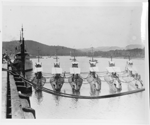 0806706 |
921k | Six O-boats nested alongside a pier, in the Central American or Caribbean area, circa 1923-1924. O-7 (SS-68), O-6 (SS-67), and O-9 (SS-70) are the three outboard submarines. Quail (AM-15) is also alongside the pier, in the right background. | USNHC photograph # NH 93672. Courtesy of the Estate of Virginia Cornwell, 1982. | |
 |
78k | O-6 (SS-67), underway at Guantanamo Bay, Cuba, circa the early 1920s. The original image is printed on postal card ("AZO") stock. It was photographed by Denson. | USNHC photograph # NH 103054. Donation of Dr. Mark Kulikowski, 2005. | |
 |
156k | O-6 (SS-67), underway, starboard side view, possibly circa 25 July 1924 while stationed at Coco Solo, C.Z. O-6 shows a typical post-WW I radio receiving antenna, comprising insulated loops running fore & aft of her bridge. The antenna were supported by the clearing lines intended to keep obstacles such as mine cables from fouling the deck. The loop antennas were first demonstrated in 1918, when a submarine at a 21-ft depth off New London CT., received European radio stations (29-30 kHz). The fore & aft loops were directional & generally supplemented by a pair of small pancake loops in sealed wooden containers in the bridge wings. The post forward of the bridge fairwater is actually the barrel of a 3 in/23 gun on a disappearing mount. |
Partial text courtesy of DANFS & courtesy of U.S. Submarines Through 1945, An Illustrated Design History by Norman Friedman. Naval Institute Press. USN photo courtesy of ussubvetsofwwii.org. | |
 0806917 | 484k | 3 O-boats bows: Broadside view of O-8 (SS-69) with two other unidentified O-boats moored to a buoy in Gatun Lake, Panama, approximately 1925. The famous Gatun Dam can be seen in the background, with the hydroelectric power station building on the right. The dam is the centerpiece of the canal, providing water for the 21 mile long lake as well as for the majority of the rest of the canal. It also provides power to operate the locks as well as for the needs of the surrounding population. | Photo i.d. & text courtesy of David Johnston (USN, retired) USN photo thanks to Jim Kurrasch @ Battleship Iowa, Pacific Battleship Center. | |
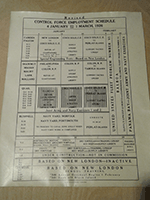 |
1.72k | Control Force Employment Schedule, 4 January to 1 March 1926. US Fleet Problem Number VI. | Photo courtesy of Steve Ireland. | |
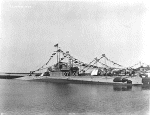 |
109k | Partial view of O-6 (SS-67), & beyond, O-7 (SS-68), October 1928, place unknown. | USN photo. | |
 |
67k | These O type and S type submarines which were used during the World War have since been decommissioned and are now laid up in the Phila. Navy Yard. The peaceful surroundings are quite a contrast to those of their active war days. They are pictured here on 17 July 1936. The S-10 (SS-115) was decommissioned on the day this photo was taken at Philadelphia Navy Yard, Philadelphia, PA. and laid up in the Reserve Fleet. Pictured also are any of the following boats that were at the PNY during this time. The O boats: O-1 (SS-62), O-2 (SS-63), O-3 (SS-64), O-6 (SS-67), O-7 (SS-68), O-8 (SS-69), O-9 (SS-70), O-10 (SS-71). The S boats: S-6 (SS-111), S-7 (SS-112), S-8 (SS-113), S-9 (SS-114), S-11 (SS-116), S-12 (SS-117), S-13 (SS-118), S-14 (SS-119), S-15 (SS-120), S-16 (SS-121), S-17 (SS-122) & S-48 (SS-159). |
Photo & text courtesy of A.P. Wire courtesy of philly.com. | |
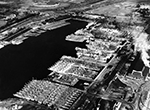 |
2.49k | Philadelphia Navy Yard, 28 October 1940. The photo presented panorama military shipyards in Philadelphia Navy Yard. Most of the ships are obsolete US destroyers, that were transfer to Great Britain under lend lease. The submarines are on the left hand side of the photo, and they are: (in no particular order) The O boats:O-1 (SS-62), O-2 (SS-63), O-3 (SS-64), O-6 (SS-67), O-7 (SS-68), O-8 (SS-69), O-9 (SS-70), O-10 (SS-71). The R boats: R-1 (SS-78), R-2 (SS-79), R-3 (SS-80), R-5 (SS-82), R-6 (SS-83), R-7 (SS-84), R-8 (SS-85), R-9 (SS-86), R-10 (SS-87), R-12 (SS-89), R-15 (SS-92), R-16 (SS-93), R-17 (SS-94), R-18 (SS-95), R-19 (SS-96) & R-20 (SS-97). The S boats: S-11 (SS-116), S-12 (SS-117), S-13 (SS-118), S-14 (SS-119), S-15 (SS-120), S-16 (SS-121), S-17 (SS-122) & S-48 (SS-159). The Olympia (C-6) is shown at the right of the wharf on Broad Street. The stadium in the upper left, was John F. Kennedy Stadium (formally Philadelphia Municipal Stadium) that stood from 1926 to 1992. It was erected for the 1926 Sesquicentennial. |
Photo i.d. courtesy of Ron Reeves (of blessed memory). Photo courtesy of flickr.com. Lower resolution photo. (548k) |
|
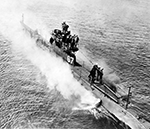 |
523k | O-6 (SS-67), underway, portside view, off New London, CT, in 1942. | USN photo # 80-G-15819 courtesy of National Museum of the U.S. Navy via flickr.com. | |
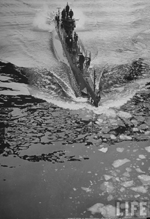 |
351k | O-6 (SS-67) roaring through the ocean off New London, CT, in 1942. | Photographer: Dimitri Kessel, courtesy of time.com. via & Life. | |
| Back To The Main Photo Index | Back To the Submarine Index |
|
Problems and site related matters, E-mail Webmaster |
|
This page is created and maintained by Michael Mohl All Pages © 1996 - 2025 NavSource History |